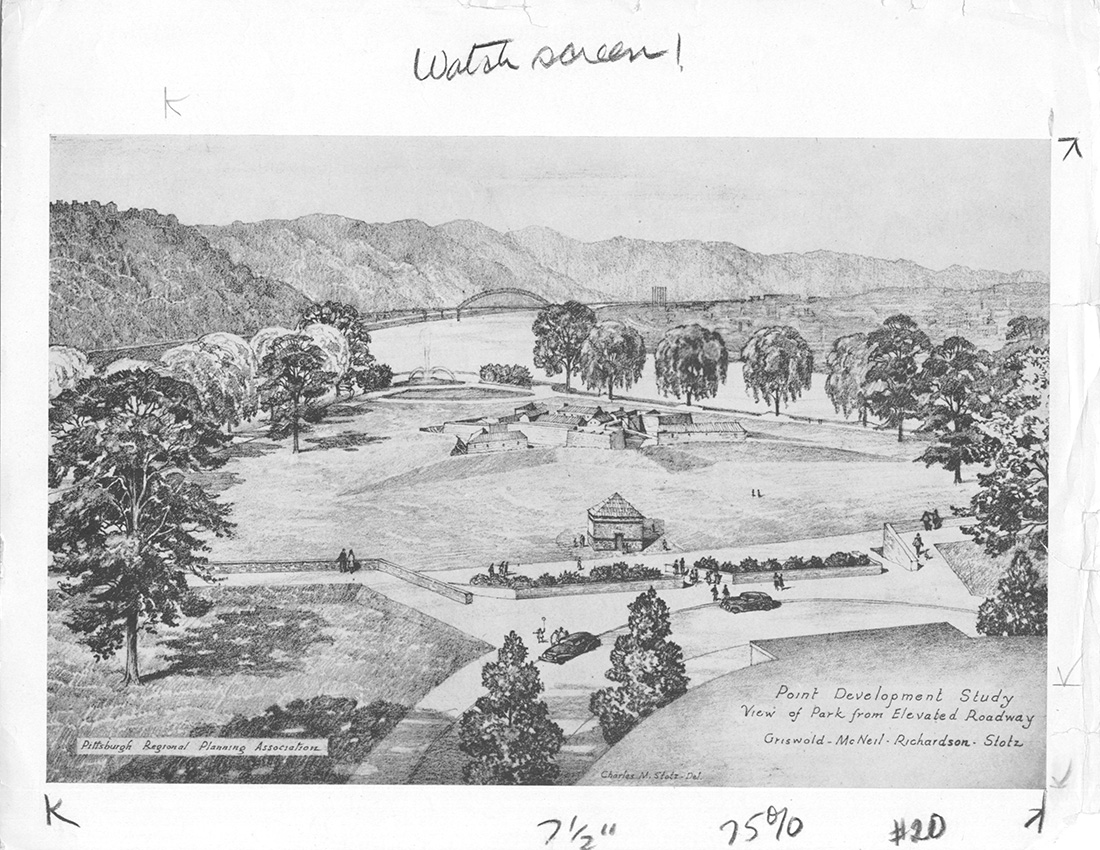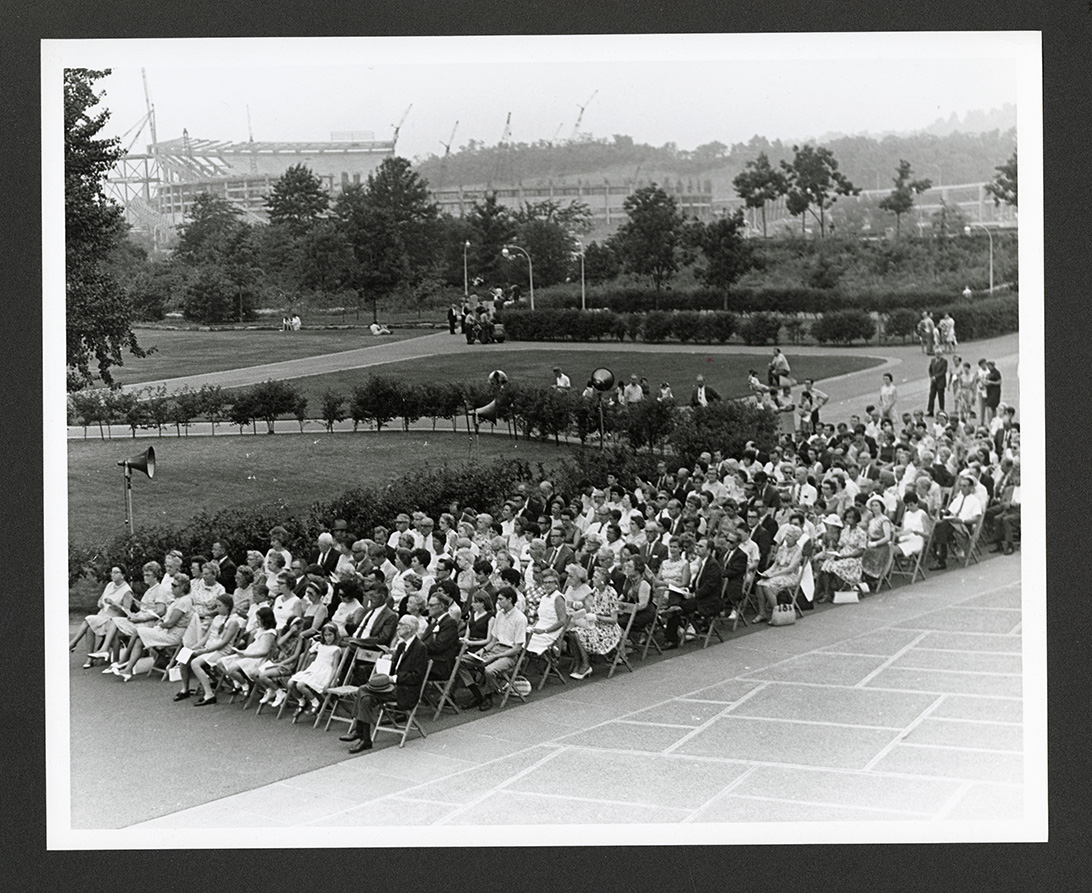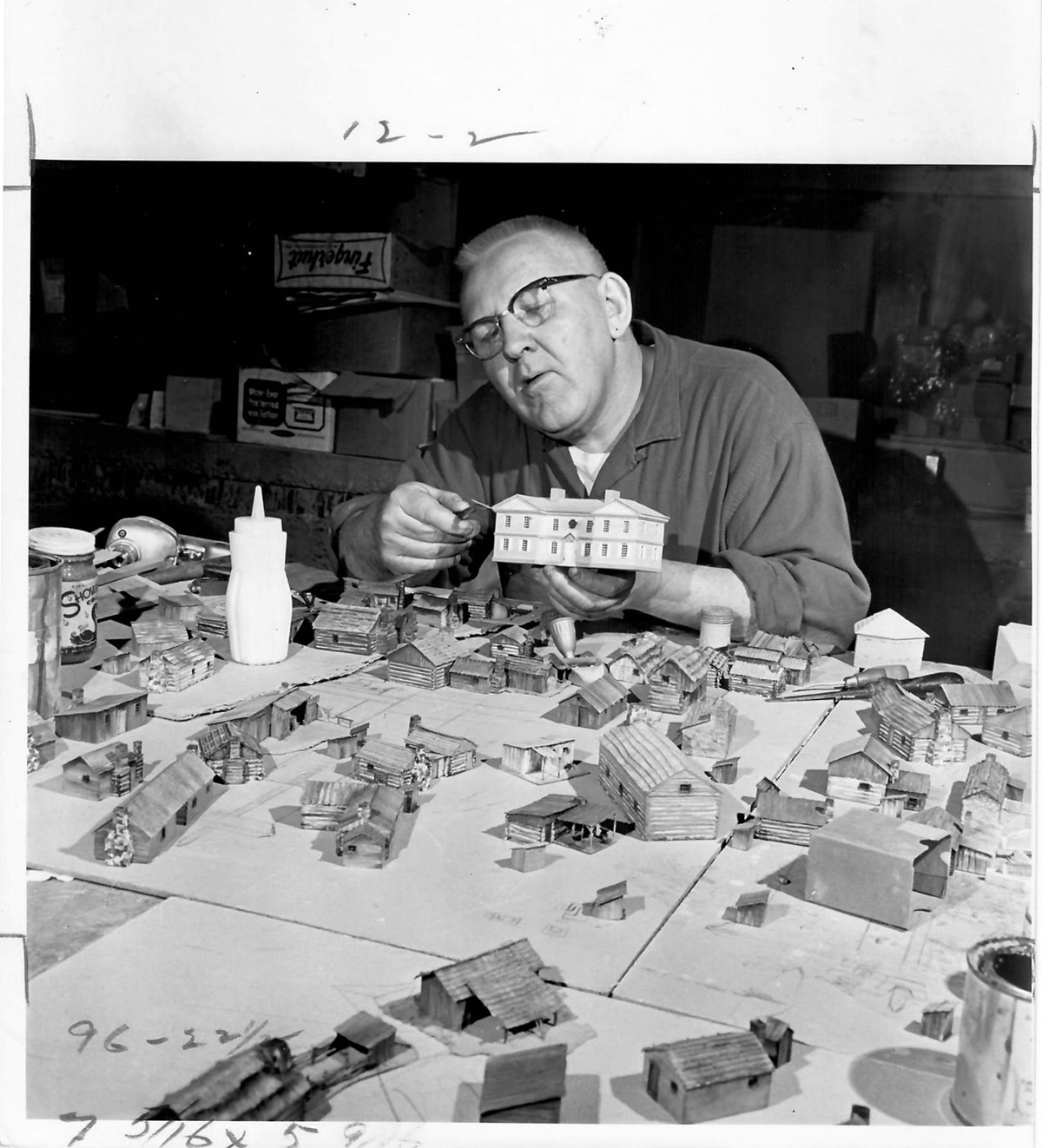This is the first in a two-part series adapted from an article found in Western Pennsylvania History magazine. Read the full article in the Summer 2019 issue.
Fifty years ago, on June 30, 1969, the Fort Pitt Museum was formally dedicated and opened to the public, but the idea to honor the historic Forks of the Ohio River goes back much further.
In 1836, a book of letters was published that described the roads, rivers, and people of Pennsylvania. The author noted that Pittsburgh was “one of disappointment” because the countryside was beautiful but the town was filled with “noise, and dust, and smoke.”[1] Though Pittsburgh was an industrial area with very little green space, the author noted there was potential for improvement at the Forks.
The events that took place at the Forks and the rest of Western Pennsylvania—including the French and Indian War, American Revolution, and diplomatic relations with American Indians—had lasting effects. The Forks, now known as The Point, was an area not only worth saving, but remembering, and one of the organizations at the front of the movement to memorialize The Point was the Historical Society of Western Pennsylvania (HSWP), which forms the heart of today’s Heinz History Center.
At its regular meeting on April 27, 1937, HSWP passed a resolution that recognized the Point as an area of local and national significance and stated that the society would organize “a movement to secure a proper national recognition and commemoration of the epochal events which transpired here, the commemoration to take the form of a national historic park at the Point, including the sites of Fort Duquesne, Fort Pitt, and the Block House, which such monuments as would be proper.”[2]

One of the HSWP members, who later served on its board of trustees, was Charles M. Stotz, an architect known for his study of early Western Pennsylvania architecture. Born and raised in Ingram, Stotz loved the region. He told the Press, “Pittsburgh is a place where people have been doing things.… We ought to have some record of our past in the future.”
In 1945, Pennsylvania Gov. Edward Martin committed funds to the creation of a state park at the Point. The “Point Park Development Study,” made public in The Pittsburgh Press, said the park would be simple, “taking full advantage of the beauties of the sites, yet with plenty to remind visitors of the world-changing events that transpired there.”[3] The plan included an area for mooring boats, a restaurant, a Fort Pitt Memorial building with graphic panels illustrating the history of the Point, a restoration of Fort Duquesne, and a fountain fueled by the waters of the Allegheny and Monongahela Rivers.
Stotz was responsible for the report on historical and architectural features, which included his suggestion to build a replica Fort Duquesne. “Of all these forts the largest and most pretentious was the second Fort Pitt, but the most significant historically was Fort Duquesne which stood as the symbol of French occupation and established control of the headwaters of navigation to the inland basin for four years … there was indeed a great question whether the civilization of inland America would be French or British.”[4] Stotz did acknowledge, however, that Fort Pitt had both sentimental and popular interest. The Fort Pitt Memorial building would contain a scale model of the fort and graphics explaining the history, but no full restoration or museum building in order to reduce the number of structures in the historic space.
On May 18, 1950, demolition began on the first building in the area that would become Point State Park. After demolishing more than 40 buildings, ground was broken for Point State Park on January 15, 1953. This also required a traffic solution that did not compromise park acreage or the view of the fountain from the city. By then, Pittsburgh was on the nation’s radar for its revitalization project—the Renaissance—and was featured in major publications such as Newsweek, Wall Street Journal, and National Geographic.
In the 16-year gap between the groundbreaking of Point State Park and the opening of the Fort Pitt Museum in 1969, progress was slow, but the park was being used and it served as the site of the city’s 200th anniversary celebration.
During construction and grading in the 1950s and ’60s, Carnegie Museum of Natural History conducted archeological surveys to rescue any items of historical significance and identify the locations and outlines of Fort Duquesne and Fort Pitt. Both studies discovered original bricks, mortar, and stone. While there was not an overabundance of 18th-century material, the studies were successful in confirming the location of historic Fort Pitt.
During planning and construction for Point State Park, it became obvious that a full-size reconstruction of Fort Duquesne was not possible because an accurate structure would need to be periodically rebuilt, plus it would block the view of the iconic fountain.[5] Therefore, the Point Park Committee, following the advice of Stotz, created a subcommittee in 1957 to build a “Museum in the Bastion.”[6] The Point Park Committee began fundraising and working with the Pennsylvania Historical and Museum Commission (PHMC) to research and design the exhibits and operate the museum. In addition, HSWP was to serve as a custodian of collection pieces until the building was completed.

The Fort Pitt Museum’s first curator, and person responsible for exhibit research in collaboration with Stotz, was John Harpster, a Western Pennsylvania native who later served as director of HSWP. His also taught at the University of Pittsburgh and worked as an archivist at the Carnegie Library. At HSWP, he also served as a curator, orchestrated two-day history tours throughout Western Pennsylvania, organized the society’s collections, and created exhibitions in its modestly sized museum.[7]
While still under construction, the Fort Pitt Museum opened its entry hall, named William Pitt Memorial Hall, on July 3, 1967. Presentations showed visitors what they could expect when the museum was finished. Also available was the museum’s first temporary exhibit, Allegheny City Architecture, the Unsuspected Treasure. Pittsburgh History and Landmarks Foundation created and mounted the exhibit that focused on the area’s lesser-known buildings and unique architectural features, including a pair of cast iron facades on Liberty Avenue and a small brick house on the hill above the South Side.[8] Although only one room of the museum was open, staff did not expect the number of visitors[9] received that first month; by the end of July, the Fort Pitt Museum counted 28,157 visitors through its turnstiles. By February 1968, the museum had welcomed 100,000.[10]

As Pittsburghers enjoyed the one-room exhibit, work continued to complete the museum’s other 60 exhibits. Pittsburgh-based Holiday Displays completed most of the work to design, develop, and install the museum’s mannequins, dioramas, exhibits, cases, and four rooms: a fur trader’s cabin, a casemate, barracks, and an 18th-century living room.[11] Raymond Yoest and his nephew, Harold Yoest, owner/operators of Holiday Displays, had done work at Fort Ligonier Museum, Drake Well Museum, and pieces commissioned by the PHMC. Their most recognizable work at the Fort Pitt Museum today is the 20-foot-diameter Fort Pitt model in the center of William Pitt Memorial Hall. The model is built at 1:120 scale (one-inch equals 10 feet), aka TT scale—which stands for “table top.” Compared to other model train sizes, it is larger than N scale (1:160) and smaller than HO scale (1:87.1), making TT scale uncommon in the United States. The model contains 1,500 hand-made, fingernail-size figures and buildings.[12]
Two years later, in 1969, the completed museum was dedicated and opened to the public. That event consisted of remarks from state officials and the Smithsonian Institution Director-General of Museums and music provided by the Macdonald Pipe Band.[13] The Fort Pitt Museum was open every day for 50¢ per adult and 25¢ per child.
Read part two of this series on the history of the Fort Pitt Museum as it celebrates its 50th anniversary in summer 2019.
[1] Prolix, Peregrine. “A Pleasant Peregrination Through The Prettiest Parts of Pennsylvania” (Philadelphia: Grigg and Elliot, 1836), pg. 104-105.
[2] “Historical Society of Western Pennsylvania Resolution.” Allegheny Conference on Community Development, Detre Library & Archives, Heinz History Center.
[3] “Beauty Spot for City—Point Park Details Told By Planners—Buildings to House Models of Old Forts,” The Pittsburgh Press, November 14, 1945, pg. 1.
[4] “General Description; Point Park Development Study, Pittsburgh Regional Planning Association, November 14, 1945,” Allegheny Conference on Community Development, Detre Library & Archives, Heinz History Center.
[5] Once a full restoration of Fort Duquesne was not possible, the site would become a state park instead of National Park that required fully restores historic structures. However, Point State Park was designated a National Historic Landmark in 1975.
[6] Alberts. “Shaping of the Point,” p. 163.
[7] Correspondence from John Harpster to Dr. S.K. Stevens, February 2, 1959. Papers of John Harpster, Detre Library & Archives, Heinz History Center.
[8] “Press Release July 16, 1967 – Special to Pittsburgh Press,” Allegheny Conference on Community Development, Detre Library & Archives, Heinz History Center.
[9] The staff that opened the Museum in 1967 included Director Lynn R. Bailey, Curator John Harpster, and Secretary-Registrar Elizabeth Wallace Hood. In 1968, Bailey and Harpster had left their positions for other opportunities. When the Fort Pitt Museum opened in 1969, the new director/curator was Rex Lohmann. Douglas Preston, an assistant curator, was hired in 1971.
[10] Spatter, Sam. “Fort’s Museum Proves Historic Lure,” The Pittsburgh Press, February 23, 1968, pg. 2.
[11] Currently, the fur-trader’s cabin, casemate, and barracks are the only rooms remaining from the original 1969 design.
[12] Wintermantel, Ed. “History in the Making,” The Pittsburgh Press, June 8, 1969, pg. 12.
[13] “Ceremonies of Dedication—Fort Pitt Museum—Point State Park Pittsburgh, PA—June 30, 1969 Seven thirty p.m.” Allegheny Conference on Community Development, Detre Library & Archives, Heinz History Center.
Kathleen Lugarich is the education manager at the Fort Pitt Museum.
